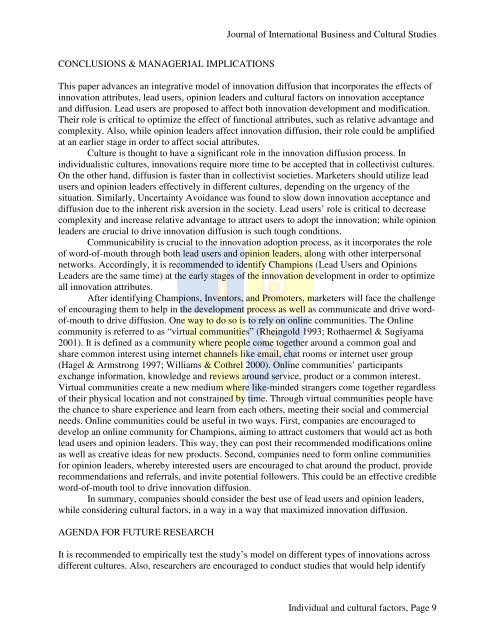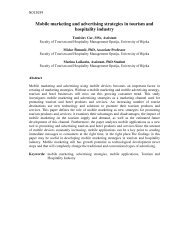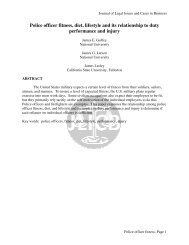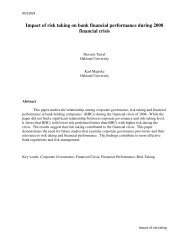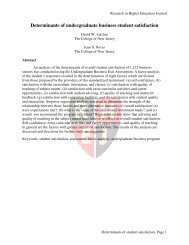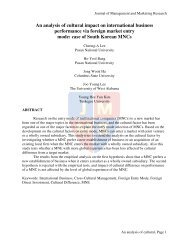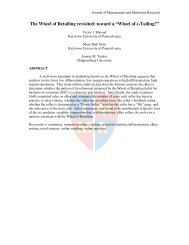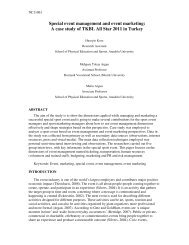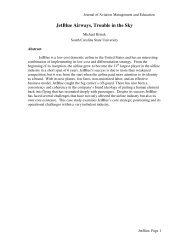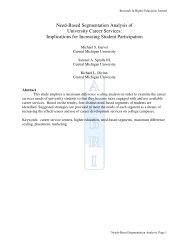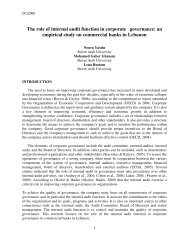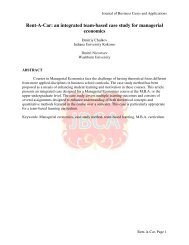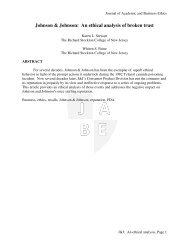Individual and cultural factors affecting diffusion of innovation
Individual and cultural factors affecting diffusion of innovation
Individual and cultural factors affecting diffusion of innovation
You also want an ePaper? Increase the reach of your titles
YUMPU automatically turns print PDFs into web optimized ePapers that Google loves.
CONCLUSIONS & MANAGERIAL IMPLICATIONS<br />
Journal <strong>of</strong> International Business <strong>and</strong> Cultural Studies<br />
This paper advances an integrative model <strong>of</strong> <strong>innovation</strong> <strong>diffusion</strong> that incorporates the effects <strong>of</strong><br />
<strong>innovation</strong> attributes, lead users, opinion leaders <strong>and</strong> <strong>cultural</strong> <strong>factors</strong> on <strong>innovation</strong> acceptance<br />
<strong>and</strong> <strong>diffusion</strong>. Lead users are proposed to affect both <strong>innovation</strong> development <strong>and</strong> modification.<br />
Their role is critical to optimize the effect <strong>of</strong> functional attributes, such as relative advantage <strong>and</strong><br />
complexity. Also, while opinion leaders affect <strong>innovation</strong> <strong>diffusion</strong>, their role could be amplified<br />
at an earlier stage in order to affect social attributes.<br />
Culture is thought to have a significant role in the <strong>innovation</strong> <strong>diffusion</strong> process. In<br />
individualistic cultures, <strong>innovation</strong>s require more time to be accepted that in collectivist cultures.<br />
On the other h<strong>and</strong>, <strong>diffusion</strong> is faster than in collectivist societies. Marketers should utilize lead<br />
users <strong>and</strong> opinion leaders effectively in different cultures, depending on the urgency <strong>of</strong> the<br />
situation. Similarly, Uncertainty Avoidance was found to slow down <strong>innovation</strong> acceptance <strong>and</strong><br />
<strong>diffusion</strong> due to the inherent risk aversion in the society. Lead users’ role is critical to decrease<br />
complexity <strong>and</strong> increase relative advantage to attract users to adopt the <strong>innovation</strong>; while opinion<br />
leaders are crucial to drive <strong>innovation</strong> <strong>diffusion</strong> is such tough conditions.<br />
Communicability is crucial to the <strong>innovation</strong> adoption process, as it incorporates the role<br />
<strong>of</strong> word-<strong>of</strong>-mouth through both lead users <strong>and</strong> opinion leaders, along with other interpersonal<br />
networks. Accordingly, it is recommended to identify Champions (Lead Users <strong>and</strong> Opinions<br />
Leaders are the same time) at the early stages <strong>of</strong> the <strong>innovation</strong> development in order to optimize<br />
all <strong>innovation</strong> attributes.<br />
After identifying Champions, Inventors, <strong>and</strong> Promoters, marketers will face the challenge<br />
<strong>of</strong> encouraging them to help in the development process as well as communicate <strong>and</strong> drive word<strong>of</strong>-mouth<br />
to drive <strong>diffusion</strong>. One way to do so is to rely on online communities. The Online<br />
community is referred to as “virtual communities” (Rheingold 1993; Rothaermel & Sugiyama<br />
2001). It is defined as a community where people come together around a common goal <strong>and</strong><br />
share common interest using internet channels like email, chat rooms or internet user group<br />
(Hagel & Armstrong 1997; Williams & Cothrel 2000). Online communities’ participants<br />
exchange information, knowledge <strong>and</strong> reviews around service, product or a common interest.<br />
Virtual communities create a new medium where like-minded strangers come together regardless<br />
<strong>of</strong> their physical location <strong>and</strong> not constrained by time. Through virtual communities people have<br />
the chance to share experience <strong>and</strong> learn from each others, meeting their social <strong>and</strong> commercial<br />
needs. Online communities could be useful in two ways. First, companies are encouraged to<br />
develop an online community for Champions, aiming to attract customers that would act as both<br />
lead users <strong>and</strong> opinion leaders. This way, they can post their recommended modifications online<br />
as well as creative ideas for new products. Second, companies need to form online communities<br />
for opinion leaders, whereby interested users are encouraged to chat around the product, provide<br />
recommendations <strong>and</strong> referrals, <strong>and</strong> invite potential followers. This could be an effective credible<br />
word-<strong>of</strong>-mouth tool to drive <strong>innovation</strong> <strong>diffusion</strong>.<br />
In summary, companies should consider the best use <strong>of</strong> lead users <strong>and</strong> opinion leaders,<br />
while considering <strong>cultural</strong> <strong>factors</strong>, in a way in a way that maximized <strong>innovation</strong> <strong>diffusion</strong>.<br />
AGENDA FOR FUTURE RESEARCH<br />
It is recommended to empirically test the study’s model on different types <strong>of</strong> <strong>innovation</strong>s across<br />
different cultures. Also, researchers are encouraged to conduct studies that would help identify<br />
<strong>Individual</strong> <strong>and</strong> <strong>cultural</strong> <strong>factors</strong>, Page 9


